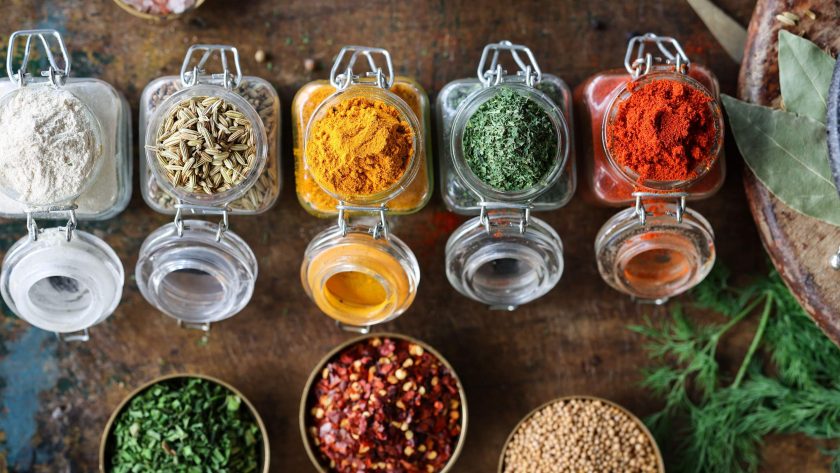The realm of gastronomy boasts incredible diversity, with every part of the world presenting its unique, mouth-watering culinary masterpieces. One of the crucial elements that add depth and complexity to these dishes is their spices, which come in a multitude of forms and flavors. As consumers become increasingly adventurous with their taste buds, it’s essential to learn about the wide array of seasonings available.
Spices and flavorings can transform the most straightforward meal into an exquisite dining experience. These powerful ingredients not only awaken our palates but also enrich our dishes with culture and tradition. From the rich five-spice blend of China to the earthy textures of Middle Eastern Za’atar, there’s a whole world of taste to explore.
Guiding you through the assortment of seasonings used worldwide, this article aims to broaden your culinary horizons. It touches not only on the most popular types but also introduces lesser-known but equally exciting flavor enhancers. Whether you’re an aspiring chef or simply a lover of good food, understanding this topic will undoubtedly enrich your culinary endeavours.
From your everyday salt and black pepper to exotic blends like garam masala and herbes de Provence, let’s undertake a flavourful journey through the world of kitchen spices.
Transform Your Recipes with Diverse Spice Mixtures
The culinary world offers an abundance of diverse condiments, each possessing their unique characteristics and the power to elevate a dish from average to exceptional. Multiple varieties of spice combinations enable chefs and home cooks to venture beyond traditional tastes and explore unique flavour profiles. These aromatics not only bring out the natural tastes of food but can also add a world of new flavors to a dish.
Across various cultures and cuisines, different kinds of spice blends may be found. Mastering their uses can truly take your cooking abilities to the next level. Inculate an understanding of different kinds of spices, learn when and how to use them and experience the magical transformation they make in your meals.
Variety of Condiments to Take your Culinary Skills to the Next Level
Spices vary widely depending on geography, culture, and personal preference. Certain seasonings are popular within specific cuisines due to the local palates and availability of ingredients. Here are a few popular examples:
- Curry Powder: An Indian staple, curry powder contains a blend of turmeric, coriander, chili powder, and a range of other spices. The profile can vary from sweet to spicy, depending on the blend.
- Herbes de Provence: This Mediterranean mixture commonly includes a combination of dried herbs like thyme, basil, rosemary, and lavender. It pairs wonderfully with grilled meats and vegetables.
- Allspice: A staple in Caribbean cuisine, Allspice is a strong and complex spice derived from the dried fruit of the Pimento Dioica plant. Often mistaken for a blend, Allspice owes its name to its multifaceted flavour profile, which elicits notes of cinnamon, nutmeg, and cloves.
- Five Spice Powder: A staple in Chinese cooking, typically containing cloves, Szechuan peppercorns, fennel, star anise, and cinnamon. It brings a deep, sweet, and warm taste to a dish.
Learning to navigate a variety of seasonings can truly transform your cooking. Don’t hesitate to experiment with different condiments and spices from various cuisines. In the end, the art of cooking is all about exploration and discovery!
Diving into the World of Culinary Seasonings
Any great cook knows that the essence of delicious food often lies in the appropriate use of seasonings. These powerful ingredients play the decisive role of enhancing, marrying, and introducing flavors in any dish. The world of culinary seasonings is diverse and vast, ranging from simple table salt to exotic types of herbs and spices from around the globe. Understanding these seasonings and their impact on food is a culinary science that every ardent cook or chef should delve into.
Seasonings are like the secret tools in a chef’s toolbox. Used correctly, they can transform a bland dish into something that tantalizes the taste buds. However, using them inappropriately can overwhelm the food, masking its original flavor and ruining the taste balance. It’s akin to an art form, knowing when, how much, and what combination of seasonings to use require experience and comprehensive understanding.
Culinary Seasonings and Their Role
In a nutshell, the primary purpose of culinary seasonings is to enhance the flavors of food – making it more enjoyable and satisfying. But delving deeper, we realize there’s an array of other roles they play:
- Building flavor: Certain seasonings are used at the beginning of cooking to build a flavor base. For instance, onions and garlic are often sautéed in oil to create a flavor foundation for other ingredients to build upon.
- Adding depth: Some seasonings are ideal for adding depth and complexity to dishes. Consider herbs like rosemary and thyme, or spices like cumin and paprika – they lend a deep aromatic finish that resonates throughout the dish.
- Boosting umami: Enhancing the savory taste or ‘umami’ in a recipe can be done using specific seasonings. Ingredients like soy sauce, parmesan cheese, and mushrooms are packed with glutamates, triggering the savory taste receptors in our palate.
- Bringing harmony: Often, the function of a seasoning is to bring harmony between different components in a dish. Acidic seasonings like vinegar and lemon juice can cut through the richness of fatty foods, creating a balanced taste palate.
Knowledge and proper execution of culinary seasonings can make a world of difference to your recipes. Whether you’re a novice cook who wants to boost your dishes or a professional chef who desires to best exploit the flavor potential of your ingredients, understanding the endless possibilities of seasonings is the key.
Experience Nature’s Majesty with Herbal Culinary Enhancers
The power and excitement of culinary experimentation lie in the surge of color, taste, aroma that various ingredients bring to the table. Indeed, one of the most versatile of these elements comes in the form of herbal seasonings, contemporary answers to ancient spices that remain true to their roots while adding a unique blend of charm and character like no other.
Capturing the piquancy of the environment in their essence, these herbal culinaries hold something of the wilderness, something of the ocean, something of the earth, and blend it all together for a slice of the world caught in time. These are the botanical garnishes that inspire artists and chefs alike, as they bring their dishes to life.
Echoes of Green: A Sensory Exploration
Thyme, sage, rosemary, parsley and many more, each reflect an individual palate of the world. These are garnishes that do more than just emphasize flavor; they’re embellishments that generate a sensory explosion, a flavor palette that transcends the ordinary.
- Rosemary: with its fragrant pine-like aroma and taste, it adds layers to roasted vegetables, grilled meats, and baking delights. It evokes the coziness of a warm night by the fire.
- Thyme: carries a whimsical, earthy appeal that goes far beyond just culinary applications. It brings out the wonderful flavors in soups, stews, and roasts.
- Sage: is distinguished by its slightly peppery flavor, and it escalates the taste of various dishes, especially stuffing and pasta.
- Parsley: it’s mild and grassy flavor is used as a decorative garnish as well as a staple in pesto and marinades.
As flavorful as they are, these botanical embellishments are not merely taste boosters – they are miniature time capsules. Utilizing them in your dishes means travelling through time and capturing the essence of various cultures and traditions, all while remaining in the comfort of your own kitchen.
The Wellness Connection
Moreover, these herbal culinary enhancers do not only bless our taste buds but also nourish our bodies. They are packed with essential vitamins, minerals and antioxidants, offering a natural source of nutrients and phytochemicals beneficial for overall well-being. Using them regularly in meals not only ensures a burst of flavor but also promotes health.
So next time you cook, remember to season it liberally with any of these green treasures. It’s not merely about adding something extra to your food – it’s about embarking on a journey with each and every bite.
The Inferno of Flavors from the Orient
The very essence of eastern culinary culture is embodied in the sheer variety and usage of spices. A fusion of traditional herbs and exciting flavors, these seasonings introduce a heat and complexity that are quintessentially Eastern, forever leaving a sensory imprint on the palette.
These spices represent more than just additions to a dish; they are a reflection of the region’s vibrant history and diverse agricultural richness. Playing a central role for centuries in trade, mythology, and traditional medicine, these exotic seasonings are still widely sought after globally.
Signature Eastern Spices
- Cumin: Ground cumin seeds add a warm, earthy flavor to a variety of Eastern dishes.
- Turmeric: With its mild aroma and quintessential yellow color, turmeric brings characteristic warmth to curries and rice dishes.
- Cardamom: Used either in its whole form or as a powder, cardamom adds a touch of sweetness to savory dishes and desserts alike.
- Cloves: Renowned for their intense aroma and sharp, warm flavor, cloves are typically used in meat dishes and pickles.
- Fenugreek: This spice has a bittersweet taste and can be found in many Indian and Middle Eastern dishes.
These spices and many more help define the luscious heat synonymous with the gastronomy of the East. The selection, blending, and usage of these precious seasonings form an art that has been passed down generations. These practices combine to create dishes that are not just meals, but experiences of cultural immersion.
Food enthusiasts and culinary experts agree: the Eastern spice pallet is not just about the heat, but also tells a tale of interconnected cultures, far-reaching trade routes, and the mutable art of cuisine. Journey through the kitchens of colorful bazaars and bustling cities to explore the inferno of flavors that await in the East.
The Incredible Uses of Salt Beyond its Traditional Role as a Seasoning
For many, salt is a common fixture in the kitchen, used for boosting flavor in dishes. However, this versatile ingredient offers much more than just a method to enhance taste. In fact, its other uses not related to food are just as vast and impressive.
Common salt, better known as table salt, is a simple, powerful compound that can be used beyond its role as a primary seasoning. This mineral, chemically known as sodium chloride, exhibits characteristics that make it useful for numerous applications outside of culinary pursuits.
Non-Food Uses for Salt
Apart from the functionality it plays in the culinary world, salt finds significant use in other areas as well. It has several household uses and is known for its cleaning properties. Its abrasive nature makes it an effective component in removing dirt and grime. Furthermore, it’s a natural deodorizer, absorbing unpleasant odors and making it a staple in many homemade cleaners.
In terms of body care, salt works wonders as an exfoliant, sloughing off dead skin cells to make way for new, fresh skin. It also combats foot odor, soothes sore throats, and can be utilized as a natural tooth whitener.
On a larger scale, salt is used extensively in industrial applications. For instance, it is used for de-icing roads in areas prone to freezing temperatures. Sodium chloride’s ability to lower the freezing point of water makes it invaluable in maintaining safe road travel conditions during winter. It’s also utilized in the manufacturing process for a variety of products including paper, plastic, glass, rubber, and textiles.
Interestingly, salt also plays a vital role in water treatment facilities. It is used to soften hard water, making it safer and better for everyday use.
Overall, the many uses for salt illustrate its vast potential and the crucial role it plays not only in our kitchens but across multiple domains of human endeavor.
Unraveling the Range of Pepper Variants: Beyond the Ordinary Black and White
When it comes to seasoning food, pepper is an indispensable ingredient in every kitchen around the globe. Traditionally, the most common varieties are black and white pepper which are praised for their classic pungent flavor. But did you know, there’s a whole palette of peppers available with a wide range of colours, flavours, and levels of spiciness? Here, we move beyond the basic black and white to explore some of the diverse pepper varieties available to spice up your culinary adventures.
Exploring different types of pepper is not just about finding alternatives to black or white, but also about discovering new intense and surprising sensations for your palate. Each variant comes with its unique flavor profile influenced by their origin, degree of ripeness, and mode of processing. So let’s embark on a flavorful journey that promises to invigorate your dishes with exotic and nuanced tastes!
Variants of Pepper that You Should Try
- Pink Peppercorns: In spite of the name, pink peppercorns are not true peppers, but are the ripe berries from the Brazilian pepper tree. Their mildly sweet and fruity notes make them an excellent addition to desserts and creamy sauces.
- Green Peppercorns: These are the unripe berries of the Piper nigrum plant and have a fresh, slightly tangy flavor. Green peppercorns are ideal for dishes requiring a less pungent pepper flavor such as fish or chicken dishes.
- Cubeb or Tailed Pepper: Native to Java and other Indonesian islands, they carry less heat than black pepper and offer a cool, refreshing flavor with a hint of eucalyptus.
- Szechuan Pepper: Hailing from China, Szechuan peppercorns are known for their unique flavor profile that combines hints of citrus with a numbing sensation on the tongue. They are a key ingredient in many Asian cuisines.
Including these diverse varieties of pepper not only enriches your dishes but also opens up new dimensions of flavor in your culinary portfolio. So don’t shy away from trying out these flavor-packed pepper variants in your recipes!
FAQ: Different Types of Seasonings
What makes cayenne pepper a popular spice, and how is it commonly utilized in cooking?
Cayenne pepper is cherished for its ability to add heat and intensity to dishes without overwhelming the inherent flavors. Used to flavor both sweet and savory dishes, it’s a key ingredient in a variety of cuisines, appearing in everything from hot sauces and meat marinades to less expected places like chocolate desserts.
Could you detail how saffron is used in Indian cuisine and why it’s considered such a valuable spice?
Saffron, one of the oldest spices, is revered in Indian cooking for its unique ability to add deep aromatic flavor, golden-yellow color, and a hint of sweetness. Commonly used in luxurious dishes like biryanis, kheer, and other festive specialties, its high cost is due to the labor-intensive harvesting process.
How does the inclusion of garlic powder in a spice mix affect the overall flavor profile, compared to use fresh garlic?
Garlic powder offers a different taste dynamic than fresh garlic. It provides a more concentrated, earthy flavor, making it an excellent seasoning spice for dishes that need a pronounced garlic presence without the moisture of fresh cloves. It’s a staple in spice mixes because it disperses evenly throughout the dish.
Why are mustard seeds an essential spice in Indian cooking, and how are they typically incorporated in dishes?
Mustard seeds are used whole or ground in Indian cooking, releasing an aromatic, nutty flavor when fried in oil—a common first step in many recipes. They’re fundamental in curries, dals, and various vegetarian dishes, contributing a warmth and depth that’s quintessential in Indian cuisine.
Can you provide information on why mace is a common spice in European cuisine and how it influences the flavor of dishes?
Mace, an aromatic spice, is prominent in European cuisine, known for its delicate, slightly sweet flavor that enhances baked goods, meat dishes, and sauces. It’s often used in light dishes to add a dimension of warmth and complexity without the pungency associated with other spices.
What’s the significance of Chinese five spice in Asian cooking, and what spices are included in this blend?
Chinese five spice, a cornerstone in Asian cooking, includes a mix of spices: star anise, cloves, Chinese cinnamon, Sichuan peppercorns, and fennel seeds. This blend creates a balance of flavors, capturing the essence of sweet, sour, bitter, salty, and umami, used to season meat, stir-fries, and as a base for marinades.
What spices are typically found in a jerk seasoning blend, and how does it complement different cuisines?
Jerk seasoning, a Jamaican marvel, uses a blend of spices that includes allspice, cayenne pepper, cloves, cinnamon, nutmeg, thyme, and garlic. It’s an integral part of Caribbean cooking, known for adding a spicy, smoky twist to meat, particularly chicken and pork, and it has been adopted by different cuisines for its bold, versatile flavor.
How are whole spices used in Indian and Middle Eastern cooking compared to ground spices?
Whole spices are often roasted and tempered in oil at the start of the cooking process in Indian and Middle Eastern cuisines, releasing their essential oils and maximizing flavor. Ground spices, conversely, are usually added during the cooking process and give a different texture and immediate aroma, making them ideal for marinades and final seasonings.
Can you create a list of spices essential for making a homemade spice mix for mulled wine?
Certainly! A standard homemade spice mix for mulled wine includes cinnamon sticks, whole cloves, star anise, and nutmeg. Orange zest and vanilla bean can also be added for additional depth and sweetness. These spices contribute a warm, festive flavor that complements the richness of the wine.
Why is it important to store spices properly, and what is the best method for maintaining their flavor and spice?
Proper storage is crucial for maintaining the potency and flavor of spices. They should be kept in a cool, dark place, ideally in airtight containers. This practice prevents exposure to heat, light, and moisture, which can lead to a loss of essential oils and, consequently, flavor degradation. Regularly checking and replenishing your spice cabinet ensures fresh, flavorful seasonings for your dishes.
What role does red pepper play in Southeast Asian cooking, and how does it influence the flavor profile of dishes?
Red pepper is integral in Southeast Asian cooking, known for its fiery heat and slightly fruity nuance. It’s pivotal in balancing the region’s characteristic sweet, sour, and salty flavors, often used in curries, soups, and noodle dishes to add a kick, enhancing the overall depth and complexity of dishes.
How is oregano utilized in different spices mixes, and what unique taste does it bring?
Oregano is a versatile herb that features in various spice mixes, contributing a warm, balsamic and slightly bitter undertone with a hint of earthiness. Its robust flavor pairs well with other spices and herbs, making it a staple in Italian, Mexican, and Mediterranean spice blends used to add complexity to sauces, grilled meats, and vegetables.
What components are typically found in pumpkin pie spice, and how is this blend usually employed in cooking?
Pumpkin pie spice is a comforting blend of cinnamon, nutmeg, ginger, cloves, and sometimes allspice. This combination is predominantly used to add warmth and sweetness to classic fall dishes, most notably pumpkin pie. However, its use extends to various sweet and savory dishes, enhancing everything from soups to baked goods with its rich, autumnal flavors.
Could you describe the essence of a dry rub and how it differs from other cooking spices applications?
A dry rub is a mixture of ground spices and herbs, applied to the surface of meats before cooking. Unlike marinades, dry rubs do not contain liquid and are designed to create a flavorful crust, often resulting in a textured, savory exterior that seals in moisture, enhancing the meat’s flavor during grilling or roasting.
Can you explain the historical significance of the spice trade and its impact on the world?
The spice trade was a pivotal element in the world’s economy, beginning around 2000 BC. It not only introduced new spices to various cultures, transforming global culinary practices, but it also led to the exploration of new routes, conquests, and colonization, significantly shaping geopolitical and economic history through the exchange of spices, herbs, and other goods.
How do mulling spices contribute to beverages, and what does a standard list of herbs and spices in mulling spices contain?
Mulling spices typically include cinnamon, cloves, allspice, and nutmeg, with possible additions of star anise, cardamom, or orange peel. They are used to add warmth, sweetness, and a spicy zest to beverages like cider or wine, creating aromatic, flavorful drinks perfect for cold weather.
How is crushed red pepper different from other spicy ingredients, and what dishes is it typically used to add heat to?
Crushed red pepper, known for its moderate heat and slight fruity flavor, is distinct from other spicy ingredients due to its texture and spice level. It is commonly sprinkled over pizza, stirred into pasta sauces, or added into stews and soups to introduce a zesty heat that elevates rather than overwhelms other flavors.
What characterizes Cajun spice, and how does it influence the dishes it’s used in?
Cajun spice is a robust, earthy blend featuring ingredients like garlic powder, onion powder, salt, black pepper, cayenne pepper, and oregano. Originating in Louisiana, it’s synonymous with Cajun cuisine’s bold, rustic flavors and is used to season a variety of dishes from jambalaya to grilled meats, imparting a spicy, well-rounded taste profile.
Where does the spice come from in terms of one of the most common sources, and how has globalization affected the availability of new spices?
One of the most common sources of spices historically is the Spice Islands, or Maluku Islands, in Indonesia. However, with globalization, trade barriers have lessened, leading to an increased availability of spices worldwide. Different regions now cultivate a broader array of spices, and consumers enjoy access to a diverse spectrum of flavors previously limited by geography.
What is the significance of adding spices toward the end of cooking, and how does this practice affect the final dish?
Adding spices at the end of cooking is a technique used to preserve their aroma and flavor. Some spices, especially ground ones, can lose their pungency when cooked for extended periods. By introducing them in the final stages, dishes are imbued with an aromatic freshness and more vibrant taste, ensuring the spice’s character is pronounced in the finished meal.



